Showing Spotlights 105 - 112 of 158 in category All (newest first):
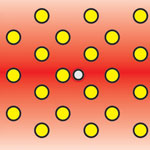 Smart phones, tablets and other electronic gadgets have become an integral part of our daily life. To maintain the steady development to even faster and smaller devices, it is desirable to replace their slow electrical data interconnects with fast optical connections. Photonic crystals are an ideal tool for such a purpose as they can guide and bend light on a nanometer scale. Surprisingly, researchers have so far been unable to truly probe inside these crystals how the light intensity is distributed - this, however, is a requirement for being able to accurately characterize the local density of electromagnetic states inside the crystal which is the key for controlling the interaction of light with matter. Researchers have now demonstrated a new concept to measure the intensity distribution of light inside photonic crystals. This method, for the first time, allows researchers to map the absolute strength of an electromagnetic field component inside a photonic crystal.
Smart phones, tablets and other electronic gadgets have become an integral part of our daily life. To maintain the steady development to even faster and smaller devices, it is desirable to replace their slow electrical data interconnects with fast optical connections. Photonic crystals are an ideal tool for such a purpose as they can guide and bend light on a nanometer scale. Surprisingly, researchers have so far been unable to truly probe inside these crystals how the light intensity is distributed - this, however, is a requirement for being able to accurately characterize the local density of electromagnetic states inside the crystal which is the key for controlling the interaction of light with matter. Researchers have now demonstrated a new concept to measure the intensity distribution of light inside photonic crystals. This method, for the first time, allows researchers to map the absolute strength of an electromagnetic field component inside a photonic crystal.
Sep 25th, 2012
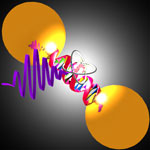 The emission of light by a single molecule is a cornerstone of nano-optics that will enable applications in quantum information processing or single-molecule spectroscopy. However, a key challenge in nano-optics is to bring light to and collect light from nano-scale systems. In conventional electronics, the interconnect between locally stored and radiated signals, for example radio broadcasts or mobile phone transmissions, is formed by antennas. For an antenna to work at the wavelength of light it is necessary to downscale the structure by the same factor as the wavelength or the frequency of the wave, i.e. roughly by a factor of 10 million. Once the nanofabrication issues are sorted out, nano-optical antennas could become ubiquitous in all applications based on light-matter interactions such as sensing, light emission (e.g. LEDs) and detection, as well as light harvesting, i.e. for solar cell applications.
The emission of light by a single molecule is a cornerstone of nano-optics that will enable applications in quantum information processing or single-molecule spectroscopy. However, a key challenge in nano-optics is to bring light to and collect light from nano-scale systems. In conventional electronics, the interconnect between locally stored and radiated signals, for example radio broadcasts or mobile phone transmissions, is formed by antennas. For an antenna to work at the wavelength of light it is necessary to downscale the structure by the same factor as the wavelength or the frequency of the wave, i.e. roughly by a factor of 10 million. Once the nanofabrication issues are sorted out, nano-optical antennas could become ubiquitous in all applications based on light-matter interactions such as sensing, light emission (e.g. LEDs) and detection, as well as light harvesting, i.e. for solar cell applications.
Jul 31st, 2012
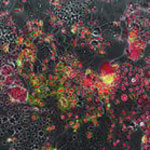 Researchers in Israel have found a unique way to affect cancer cells in a rather controllable manner. For example, they can kill these cells in various ways, or they can make them fuse together, as they like. They do so by using functionalized, 20 nm in diameter gold nanospheres and specific, intense laser pulses with a visible wavelength tuned to the plasmonic resonance of those particles. This technique may have an impact on various technologies which require sophisticated cell manipulation for therapeutic and drug development applications. What is unique about this technique is that it is highly controllable and repeatable. The structural stability of the nanospheres even after the strongest laser illumination allows them to deliver the effect over and over again, until the desired result is obtained.
Researchers in Israel have found a unique way to affect cancer cells in a rather controllable manner. For example, they can kill these cells in various ways, or they can make them fuse together, as they like. They do so by using functionalized, 20 nm in diameter gold nanospheres and specific, intense laser pulses with a visible wavelength tuned to the plasmonic resonance of those particles. This technique may have an impact on various technologies which require sophisticated cell manipulation for therapeutic and drug development applications. What is unique about this technique is that it is highly controllable and repeatable. The structural stability of the nanospheres even after the strongest laser illumination allows them to deliver the effect over and over again, until the desired result is obtained.
Jun 15th, 2012
 An international group of researchers reported a new record long distance for quantum teleportation. The authors claim a free-space distance of 143 kilometers. Quantum teleportation communicates physical information soundly without traveling directly through the space connecting the communicating parties. The reporting team includes quantum teleportation pioneer Anton Zeilinger of the Quantum Optics, Quantum Nanophysics, Quantum Information at the University of Vienna. Quantum teleportation combines classical and quantum information channels to transmit the complex state of quantum particles. The communication method conveys complete quantum information without the need to pass directly through the space between communicating parties.
An international group of researchers reported a new record long distance for quantum teleportation. The authors claim a free-space distance of 143 kilometers. Quantum teleportation communicates physical information soundly without traveling directly through the space connecting the communicating parties. The reporting team includes quantum teleportation pioneer Anton Zeilinger of the Quantum Optics, Quantum Nanophysics, Quantum Information at the University of Vienna. Quantum teleportation combines classical and quantum information channels to transmit the complex state of quantum particles. The communication method conveys complete quantum information without the need to pass directly through the space between communicating parties.
Jun 4th, 2012
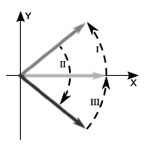 New research explores the uses of time reversal symmetry in optics, with a focus on quantum optics. The article compares time reversal with optical phase conjugation, and illustrates the concept of time reversal symmetry with several examples in classical and quantum optics. Time reversal symmetry is the physical property that events can occur in a forward or backward direction through time, with no fundamental distinction due to the direction. Time reversal symmetry applies to both classical and quantum optics, as well as areas of physics outside of optics. The property holds true in all areas of physics, with possible exceptions only under rare conditions in particle physics.
New research explores the uses of time reversal symmetry in optics, with a focus on quantum optics. The article compares time reversal with optical phase conjugation, and illustrates the concept of time reversal symmetry with several examples in classical and quantum optics. Time reversal symmetry is the physical property that events can occur in a forward or backward direction through time, with no fundamental distinction due to the direction. Time reversal symmetry applies to both classical and quantum optics, as well as areas of physics outside of optics. The property holds true in all areas of physics, with possible exceptions only under rare conditions in particle physics.
Jun 1st, 2012
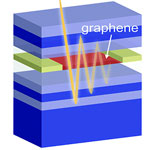 There is currently a very strong interest in using graphene for applications in optoelectronics. Graphene-based photodetectors have been realized before. By using graphene, researchers make use of the internal electric field that exists at the interface of graphene and metal. However, the low optical absorption of graphene - only 2.3 % due to its monoatomic thickness - leads to a low responsivity of these devices. Several groups worldwide are therefore currently pursuing different approaches to increase the interaction length of light with graphene and enhance the optical absorption. One novel approach is based on the integration of graphene into an optical microcavity. The increased electric field amplitude inside the cavity causes more energy to be absorbed, leading to a significant increase of the photoresponse.
There is currently a very strong interest in using graphene for applications in optoelectronics. Graphene-based photodetectors have been realized before. By using graphene, researchers make use of the internal electric field that exists at the interface of graphene and metal. However, the low optical absorption of graphene - only 2.3 % due to its monoatomic thickness - leads to a low responsivity of these devices. Several groups worldwide are therefore currently pursuing different approaches to increase the interaction length of light with graphene and enhance the optical absorption. One novel approach is based on the integration of graphene into an optical microcavity. The increased electric field amplitude inside the cavity causes more energy to be absorbed, leading to a significant increase of the photoresponse.
May 14th, 2012
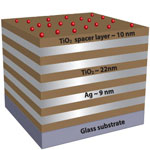 Physicists have uncovered a new method to manipulate light by borrowing an idea from the field of mathematical topology - topology is the mathematical field dealing with the properties of objects undergoing deformations, such as stretching and twisting. They created an artificial material, a "metamaterial", that can transform from regular dielectric - a substance like glass or plastic, which does not conduct electricity - to a medium that behaves like metal (reflects) in one direction and like dielectric (transmits) in the other. The research team expects optical topological transition to be the basis for a number of applications of both fundamental and technological importance through use of metamaterial-based control of light-matter interaction.
Physicists have uncovered a new method to manipulate light by borrowing an idea from the field of mathematical topology - topology is the mathematical field dealing with the properties of objects undergoing deformations, such as stretching and twisting. They created an artificial material, a "metamaterial", that can transform from regular dielectric - a substance like glass or plastic, which does not conduct electricity - to a medium that behaves like metal (reflects) in one direction and like dielectric (transmits) in the other. The research team expects optical topological transition to be the basis for a number of applications of both fundamental and technological importance through use of metamaterial-based control of light-matter interaction.
May 9th, 2012
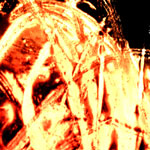 All-optical processes could allow dramatic speed increase in photonics by eliminating the need to convert photonic signals to electronic signals and back for switching. The many opportunities that all-optical processes could bring to photonics have been hampered by the lack of materials that combined photosensitivity with fast, large, and reversible changes in their optical properties at the influence of light. By exploited the universal capabilities of an 'active polymeric template' for confining, orienting, and stabilizing a wide range of self-organized materials, researchers recently have exploited a wide range of optical, electro-optical and all-optical effects which confirm the extraordinary capability of their 'active polymeric template' to induce self-organization, without using any kind of surface chemistry or functionalization.
All-optical processes could allow dramatic speed increase in photonics by eliminating the need to convert photonic signals to electronic signals and back for switching. The many opportunities that all-optical processes could bring to photonics have been hampered by the lack of materials that combined photosensitivity with fast, large, and reversible changes in their optical properties at the influence of light. By exploited the universal capabilities of an 'active polymeric template' for confining, orienting, and stabilizing a wide range of self-organized materials, researchers recently have exploited a wide range of optical, electro-optical and all-optical effects which confirm the extraordinary capability of their 'active polymeric template' to induce self-organization, without using any kind of surface chemistry or functionalization.
Apr 4th, 2012
 Smart phones, tablets and other electronic gadgets have become an integral part of our daily life. To maintain the steady development to even faster and smaller devices, it is desirable to replace their slow electrical data interconnects with fast optical connections. Photonic crystals are an ideal tool for such a purpose as they can guide and bend light on a nanometer scale. Surprisingly, researchers have so far been unable to truly probe inside these crystals how the light intensity is distributed - this, however, is a requirement for being able to accurately characterize the local density of electromagnetic states inside the crystal which is the key for controlling the interaction of light with matter. Researchers have now demonstrated a new concept to measure the intensity distribution of light inside photonic crystals. This method, for the first time, allows researchers to map the absolute strength of an electromagnetic field component inside a photonic crystal.
Smart phones, tablets and other electronic gadgets have become an integral part of our daily life. To maintain the steady development to even faster and smaller devices, it is desirable to replace their slow electrical data interconnects with fast optical connections. Photonic crystals are an ideal tool for such a purpose as they can guide and bend light on a nanometer scale. Surprisingly, researchers have so far been unable to truly probe inside these crystals how the light intensity is distributed - this, however, is a requirement for being able to accurately characterize the local density of electromagnetic states inside the crystal which is the key for controlling the interaction of light with matter. Researchers have now demonstrated a new concept to measure the intensity distribution of light inside photonic crystals. This method, for the first time, allows researchers to map the absolute strength of an electromagnetic field component inside a photonic crystal.
 Subscribe to our Nanotechnology Spotlight feed
Subscribe to our Nanotechnology Spotlight feed





